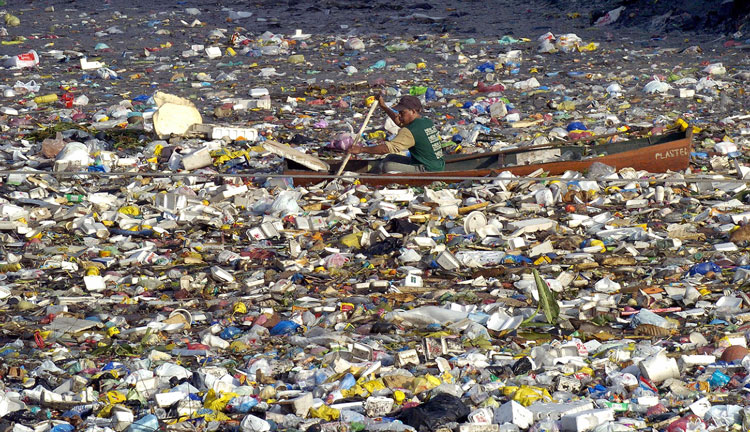Plastic in Our Body Wash, Our Toothpaste?
by Nancy Gross
When 19-year old Aerospace Engineering student Boyan Slat gave a TEDex talk about the ocean cleanup array he has designed, he referenced “The Stone Age, The Bronze Age,” and then referred to our time as “The Plastic Age,” saying, “Every year we produce about 300 million tons of plastic.” The more I take notice, the more I see the truth of this. We are in The Plastic Age. Take a look around and keep looking. Plastic is everywhere, and even where it isn’t center stage, it often forms the cartilage of the products we rely on.
If you aren’t familiar with the trash gyres in the ocean, please look them up online. Having just traveled for business and spent time in several airports, a convention center, and a hotel, I was that much more aware of the number of plastic one-time use containers that make cleanup oh so easy, except for the cleanup of the larger biosphere, since these items are not going to biodegrade for countless generations, if at all. During his TEDex talk, Slat shows the audience images of the insides of the bellies of dead Albatrosses that have been feeding on plastic bottle caps and other plastic debris. The color red says “food” to the sea bird even if it is far from being food. Plastics are in the oceans, are in all the pathways of urban runoff, and are likely affecting processes in our bodies.
Ocean Trash
A surprising and nearly invisible utilization of plastic that is of particular concern in terms of water treatment just came to my attention. It was introduced about a decade ago, and began showing up in the news as a pollutant about a year ago: tiny plastic microbeads are employed for exfoliation or to provide a “feel good factor” in many top brands’ personal care products, from body washes to toothpastes. The beads are often as small as salt particles and are not accidentally entering our waterways; rather they are designed to go down the drain. They are being found in the wastewater going out into the ocean. They have been found in large quantity in The Great Lakes, something that prompted a coalition of mayors to ask EPA to study the potential harm to humans and the ecosystem. They absorb chemicals, are ingested by fish and other organisms, and must then inevitably end up in food we eat.
On January 25, Los Angeles Times reported on the microbeads in the L.A. River, where the discharge from the Donald C. Tillman Reclamation Plant flows. A spokesman from the L.A. Department of Public Works says the plant is able to filter out all microbeads down to the size of 10 microns, or 0.01 millimeters. Markus Eriksen, a scientist with the 5 Gyres Institute, a nonprofit dedicated to researching plastics in the world’s waterways, said he doesn’t yet know the origin of the beads, but he did say they are larger than 0.01 millimeters. “Using a net only 2 feet wide for 10 minutes in a stream a few hundred feet across, I caught dozens of bits of plastic,” he said. “So, it’s easy to extrapolate that millions of plastic particles flow through this channel every day.”
According to Plastic Free Seas, these are some of the brands on the market that have products containing plastic microbeads:
Nivea (Beiersdorf)
Neutrogena (Johnson & Johnson)
Olay (Proctor & Gamble)
Biore (Kao)
Kiehl’s (L’Oreal)
Lancome (L’Oreal)
L’Oreal
Shiseido
Clinique
Boots
Estee Lauder
Superdrug
Garnier (L’Oreal)
Gatsby (Mandom Corp)
The Body Shop (L’Oreal)
Darlie (Toothpaste)
Unilever
These are excerpts from a statement by Unilever to its stakeholders.
“Small pieces of plastic material (typically under 5 mm in size) identified in the marine environment are often referred to as micro-plastics. They originate from a variety of different sources including the breakdown of larger plastic materials in the water, the shedding of synthetic fibres from textiles during domestic clothes washing, and from the use of small plastic beads, for their abrasive or other properties, in a range of consumer and industrial products.
Unilever currently uses small plastic scrub beads in a limited number of dedicated personal care products, such as exfoliating face and body washes. The plastic scrub beads are used as an ingredient because of their ability to gently remove dead skin cells from the surface of the skin. Many consumers enjoy the clean feeling that using products with the beads provides.
The amount of plastic in the marine environment thought to originate from the use of plastic scrub beads in personal care products is considered to be limited compared to other sources. However, a number of stakeholders have expressed concerns about the growing presence and potential impact of micro-plastics in the marine environment and are looking at ways in which the amount of micro-plastics can be reduced, including from the use of plastic scrub beads in personal care products.
Our position: Unilever has decided to phase out plastic scrub beads from personal care products. This is because we believe we can provide consumers with products that deliver a similar exfoliating performance without the need to use plastics. We expect to complete this phase out globally by 2015 and are currently exploring which suitable alternatives can best match the sensory experience that the plastic scrub beads provide.”
For more information visit the 5 Gyres Institute’s website.
Visit Plastic Free Seas’ article on microbeads.
Source: Water Efficiency.





